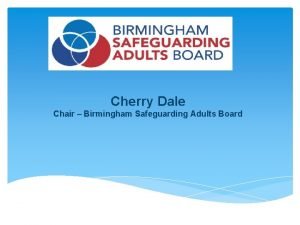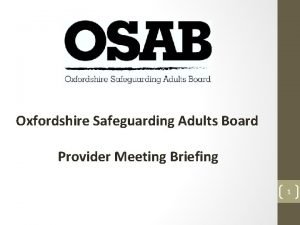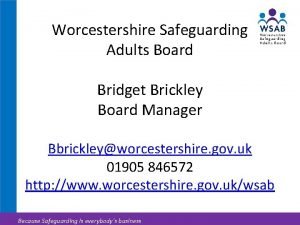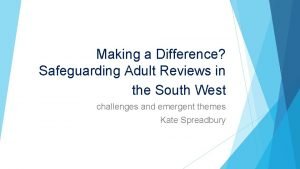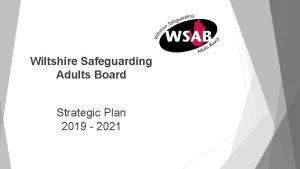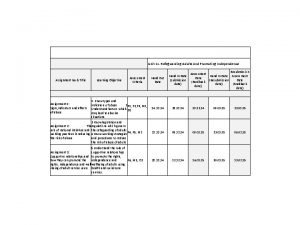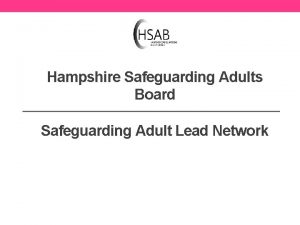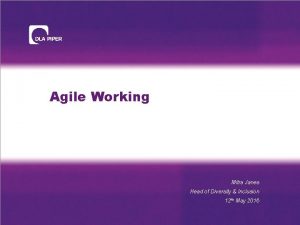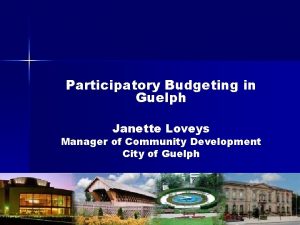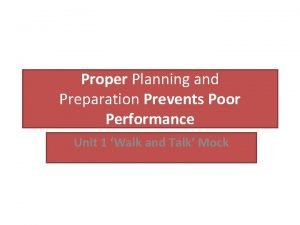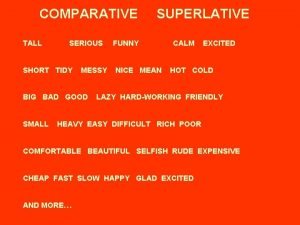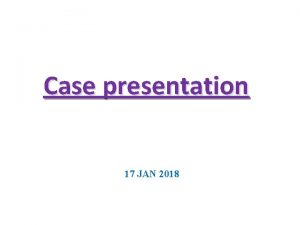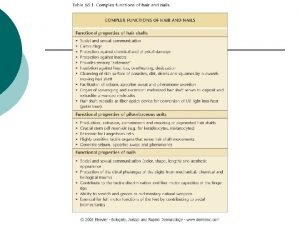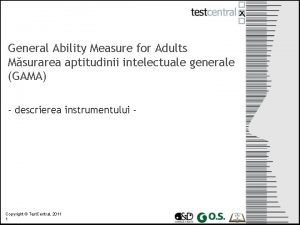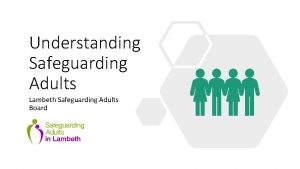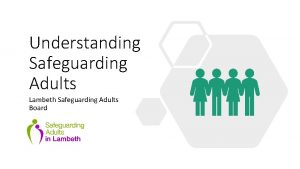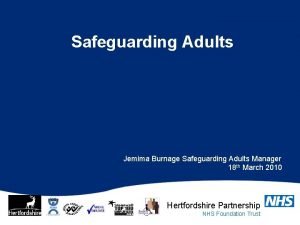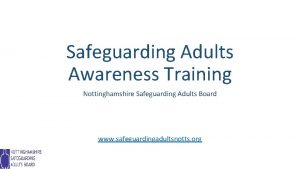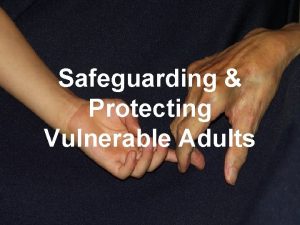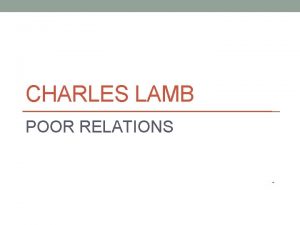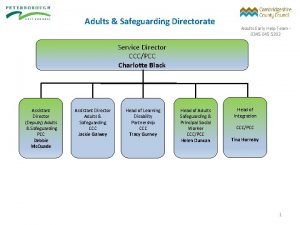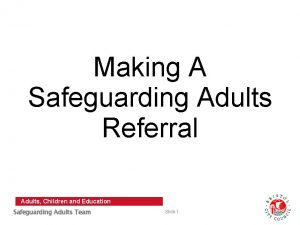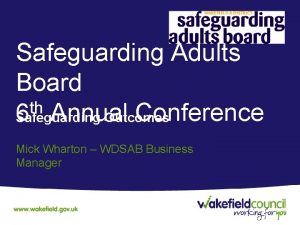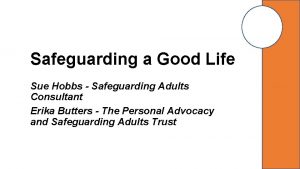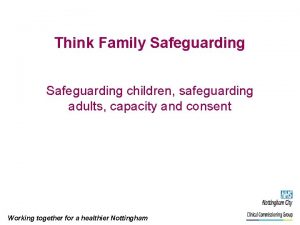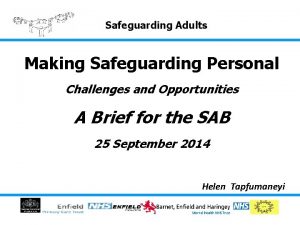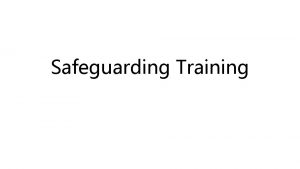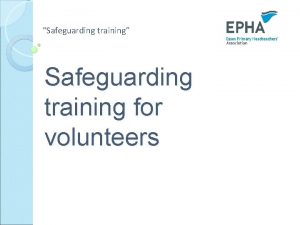Safeguarding vs Poor Practice Janette Janes Safeguarding Adults



























- Slides: 27

Safeguarding vs Poor Practice Janette Janes Safeguarding Adults Team Manager Kent County Council OPPD East Kent

2 What were the objectives of our change plan? Meet the statutory requirements for safeguarding by designing a pathway that responds promptly to concerns raised Reduce drift / timescales for safeguarding enquiries and ensure that performance measures are in place to support this Ensure the re-designed pathway delivers improved outcomes for service users, by focusing the right professional skill-set at the right time in the service user journey Through the Strategic Safeguarding function improve partnerships and levels of support where safeguarding enquiries require agency input

Safeguarding Pilot Outcomes 3 Tested in Canterbury and North Kent with positive results. Number of closures carried out in 30 days or less during the same 12 weekprocess period now. In DGS There is a clear Before the work 2017 the - 13 team which made was spread out across - 40 recording difficult. 2018 Being part of a team makes it easier Number of closures carried out in 30 days or less during the same 12 Better way of working than what it was week period In Canterbury before – get to start and 2017 - 3 finish the same case and know you have done a quality 2018 - 75 piece of work. IO reports done quicker because you get more practice and become more skilled. It felt like fire fighting before. Number of safeguarding concerns closed at Stage 1 and Stage 2 in the pilot areas for 2017 was 57. 4% of total enquiries, in the same period of the pilot Quick turnaround of sign offs has 2018 made the it was 82. 6% biggest impact. Immediate sign offs means a case is ended and then ‘gone’. Now a much safer system. Have confidence as a DSO that the IO is doing the work. More responsive approach and making people safer quicker. Drift prevented. Before a case would be triaged and then it would get put on a Fewer cases progressing to full enquiry and concerns being resolved ‘back burner’. more quickly. 3

Safeguarding Governance Hierarchy 4 Assistant Director, Social Work, Safeguarding and RMA County Service Manager Safeguarding, CRU and QI Team Manager (East) Team Manager (West) Senior Practitioners Safeguarding Officer Safeguarding Assistant

5 Team Structures West Kent Thanet & South Kent Coastal Ashford & Canterbury North Kent 3 x Senior Practitioners 4 x Safeguarding Officer 4 X Safeguarding Officer 3 x Safeguarding Officer 6 x Safeguarding Assistants 5 x Safeguarding Assistant 7 x Safeguarding Assistant 3 x SG admin 2 x SG admin

6 Role West Kent South Kent Coast, Dover, Deal & Thanet Ashford & Canterbury North Kent Senior Practitioners Jenny Baker Jarrasen Vencatasen Julie Whincup Genie Canning Sue Skinner Naomi Hill Peter Hughes Barbara Sleator Christian Naraynsingh Remi Ariyo Emma Walsh Richard Hill Safeguarding Officers Russell Woodruff Olawasegun Bada Kerrie Colter Vacancy (Media covering) Felicia Parris Anita Poole Anna Cook (on secondment) Aleksandra Jankowska Christine Cordes Sarah Iszard Lynne Hyder Louisa Craigie Matt Turner Ann Msichilli Hayley Williams Safeguarding Assistants Lauren Broster Ashleigh Camp Neil Bower Steven Lynn Yanaswaree Khusul Roseanne Butt Wendy Mac. Kenzie Clare Boyle Emma Thomas Luke Emery Alison Mc. Gregor Karen Sibley Amy Holmes Helen Stone Meghann Fyfe Kelly Collett Sandeep Khahtar Alex Mc. Evoy Bibye Higgwe Gabrielle Garton Emma Hewitt Janet Kelly Safeguarding admin Kylie Hammon Tracey Pennington Vince Williams Joshua Jordan Di Townley Laura Baker Joe Cole (on secondment) Tyler Erby – Temp Amy Payne/ Jane Pepper Office locations Oxford Road, Maidstone St Peters House, Broadstairs Worrall House, Kings Hill. Thistley Hill, Dover Montague House, Tonbridge Wells. Queens House, Folkestone Brook House, Whitstable Kroner House, Ashford Joynes House, Gravesend. Avenue of Remembrance, Sittingbourne Staff in Teams

Practitioners will triage enquiries effectively, risk assess concerns accordingly and progress cases as necessary to carry out Section 42 enquiries, meeting KCC responsibilities under the Care Act 2014. 7 Safeguarding Team – overall responsibility The responsibility of the Safeguarding team will end with the completion of an post enquiry plan that will be taken forward by one of the following: Social Work Quality Improvement Supporting Independence / Promoting Independence External partner

8 Quality Improvement Function Ensuring Providers improve their quality of care where a Safeguarding Enquiry has identified issues. Joint working with Strategic Commissioning to provide intelligence and support for Quality in Care issues. Develop and Monitor Quality Improvement Action Plans with Providers Share learning from referrals and embedded good practice across the workforce.

What is adult safeguarding? Safeguarding means protecting an adult’s right to live in safety, free from abuse and neglect. (Section 14. 7 Care Act 2014)

And what is organisational abuse? Organisational abuse – including neglect and poor care practice within an institution or specific care setting such as a hospital or care home, for example, or in relation to care provided in one’s own home. This may range from one off incidents to on-going ill-treatment. It can be through neglect or poor professional practice as a result of the structure, policies, processes and practices within an organisation.

Statutory Enquiries (section 42 Care Act 2014). Statutory Safeguarding Enquiry: (3 point test) The criteria for a Section 42 response is: an adult who is believed to: a) be experiencing, or at risk of, abuse or neglect; AND b) have needs for care AND support (whether or not the Local Authority is meeting any of those needs); AND c) as a result of those care AND support needs is unable to protect themselves from either the risk of, or the experience of, abuse or neglect.

Human nature So, why do good people do bad things, and Why do good people fail to recognise or fails to respond

Asch (1950’s) how long is a piece of string…conformity in groups 4 psychological experiments that tell us uncomfortable things about human nature… Walster- Hatfield (1966) blame determined by the outcome of carelessness not behaviour, corners cut may lead to nothing or to catastrophe Zimbardo (1971) roles define behaviour, the Stanford prison experiment, participants slipped into roles acting out stereotypes not using their own judgment or morals Milgram (1974) authority pushed to limits as electric shocks given to people who can’t answer questions when authorised to do so by someone in power

So what does this care work entail. . Containing “usual’ uncensored responses to another person and managing difficult emotional reactions such as irritation, disgust, embarrassment, boredom, and sometimes fear, aggression and loss of “the upper hand” Managing power helpfully by controlling situations not people, making clear decisions and assigning staff time and input fairly Putting on hold one’s own needs and managing one’s self and one’s physical needs throughout a day Caring for others sometimes when you are not feeling cared for yourself, which is very difficult

Constellations (not types) of abuse emerge from literature. . . Institutional abuse hate crimes 1. rigid regime 2. staff out of their depth, unmotivated or overwhelmed predatory crimes parasitic crimes in the community 3. cruel individuals 4. abuse by other service users abuses in service settings copyright Hilary Brown March 2013 Family violence, neglect or negligence 1. 2. Breaches of professional boundaries 3. 4. by powerful staff (arrogant) 5. by resentful staff (hard-done-by) risks of living alone, rogue traders, doorstep burglaries abuse in your own home partner violence abuse by adult sons or daughters abuse by parents financial abuse by more distant relatives may be exacerbated by poverty, racism or social exclusion Unethical or unauthorised practices in response to challenging needs, mental health needs, illness or dementia Discriminatory access to public resources e. g. health care, employment, benefits, legal remedies, housing systemic abuse

“they” people are lumped together Dehumanising labels, “they eat like animals”, You can hear abuse brewing in the conversations taking place in a home Sexualised language “males or females ”, “they are at it like rabbits ” “she ’s gagging for it ” Blaming explanations eg “he knows what he’s doing, ” “manipulative”, “winding me up”, Punitive responses, “they ’ve got it coming ”, “she needs to be taught a lesson ”, “if he thinks he can treat me like that “ Discounting of their feelings, “he doesn ’t notice ”, “they don ’t care ” “they are zombies ” This sets the scene for abuse, it provides the rationale and the excuses copyright Hilary Brown March 2013

But why don’t people notice sooner? Lack of a tangible sense of what is wrong Lack of certainty that their concerns are reasonable or proportionate Lack of “evidence” to back up concerns Fear of immediate reprisals or long term detrimental consequences Fear that concern or complaint will not be handled well so that their intervention will be in vain Joyce, T. and Oakes, P. (2004) Protecting people with intellectual disabilities from abuse: Why does it take so long for someone to say something Journal of Intellectual Disability Research 48 p 419 Marsland, D. Oakes, P. and White, C (2007) Abuse in Care: Early indicators of the abuse of people with learning disabilites in residential settings

Shows “gut instincts” can be articulated accurately Recent research into early indicators Themes fell into 6 domains Behaviours, actions and attitudes of managers Behaviours and attitudes of staff Behaviours of people with learning disabilities Isolation Service design, placement planning and commissioning Fundamental care and the quality of the environment Marsland, Oakes and White 2007

And that ………………. . “A significant feature of the early indicators …is that they are not complex or obscure entities. Instead they highlight tangible and often readily identifiable evidence of decaying and unsafe services. Such indicators are visible to external people who spend time in services as part of their professional roles or as a consequence of familial relationships. (Marsland et al 2007 p 17)

a) Management of the home and the organisation For example The following indicators relate to the behaviours, actions and attitudes of managers at all levels within residential services, which may place residents at risk the manager(s) either can’t or don’t want to make decisions or to take responsibility for things the manager(s) doesn’t make sure that staff meetings and supervision take place the manager hasn’t explained to members of staff exactly what they are there to do as members of staff there isn’t always a manager available to contact or to talk to the manager(s) receives little support from senior managers within the wider care organisation the manager(s) appears unable to change the way a group of strong/powerful members of staff are working the manager(s) of the home and/or organisation do not support members of staff who complain or act as whistle-blowers the manager(s) or organisation does not tell the people from social services or the health service, who set up the service and pay for the service, that the service cannot meet resident(s) needs.

For example The following indicators relate to the behaviours, actions and attitudes of managers at all levels within residential services, which may place residents at risk b) Staff recruitment, deployment and shift patterns there is high staff turnover, staff shortages or high levels of staff sickness there is high use of bank/agency members of staff morale is low or that there are members of staff who are ‘burned out’ there are frequent changes of residents’ key workers.

They also show that service level issues leak into the practice of individuals and teams “an extensive reliance on the “bad apple” model. ”…. overlooking contribution of staff cultures, management failings and isolation … yet there appears to be a tendency …to undervalue these factors and to over emphasise the importance of individual failings… So formal and informal cultures matter

These things get played out in abusive teams…… Conformity and bullying Abuses of authority and power, including racism and sexual harassment Informal leadership and cliques/favourites Negative images of, and narratives about, service users that in turn fuel Blaming, punitive, dehumanising interactions Empathy that should provide a brake is over-ridden

And these things are replayed internally When faced with difficult choices or hard challenges we argue with ourselves about how to act I am usually such a good person They are throwing it back in my face I have worked so hard for this person No-one will notice I give myself a “moral holiday” (Tomita 1996) If I want to abuse (motivation), I overcome my own scruples (internal disquietings), I evade consequences (external controls) and I overcome or discount the victim’s resistance (victim resilience/credibility) (Finkelhor 1984)

So management and containment relies on Understanding of service users and the complexity of their needs Creating positive roles for staff Careful recruitment and retention of staff Creating positive and helpful stories about the people we care for, who they are, why they do what they do, why they may have problems Modelling compassionate and containing uses of authority copyright Hilary Brown March 2013

In order to prevent organisational abuse we need……. An accurate understanding of Early indicators and manifestations Very good practice and support for difficult areas of the work Necessary infrastructure and structures that underpin acceptable care Knowledge of how abusive dynamics arise in teams and how they can be contained and managed Specialist knowledge and ordinary humanity These need to be shared and embedded in the work of the home and the wider professional and commissioning network

Thank you for Listening Any questions/comments/ob servations
 Portsmouth safeguarding
Portsmouth safeguarding Birmingham adult safeguarding
Birmingham adult safeguarding Oxfordshire safeguarding adults board
Oxfordshire safeguarding adults board Worcestershire safeguarding adults board
Worcestershire safeguarding adults board Somerset safeguarding adults board
Somerset safeguarding adults board Wiltshire safeguarding team
Wiltshire safeguarding team Unit 11 safeguarding adults and promoting independence
Unit 11 safeguarding adults and promoting independence Hampshire safeguarding adults board
Hampshire safeguarding adults board Mitra janes
Mitra janes Jeff janes
Jeff janes Stepiloom
Stepiloom Stepituhkur
Stepituhkur Janette cuevas
Janette cuevas Janette tolppi
Janette tolppi Janette loveys
Janette loveys Dragonpay validate
Dragonpay validate Michelle edwards guelph
Michelle edwards guelph Audit universe
Audit universe Yu of guelph
Yu of guelph Proper prior preparation prevents poor performance
Proper prior preparation prevents poor performance Proper preparation prevents poor performance gd
Proper preparation prevents poor performance gd Practice assessor feedback examples
Practice assessor feedback examples Funny comparative and superlative forms
Funny comparative and superlative forms Facilitation methods for adults
Facilitation methods for adults Antihyperglycemic therapy in adults with type 2 diabetes
Antihyperglycemic therapy in adults with type 2 diabetes Lanugo vs normal hair
Lanugo vs normal hair Gama iq test
Gama iq test Adults in scouting
Adults in scouting

